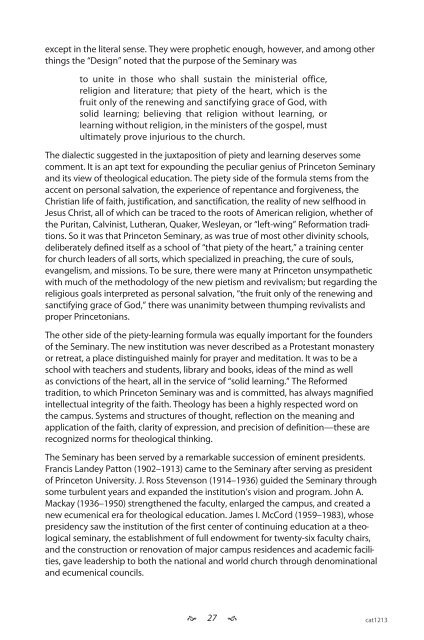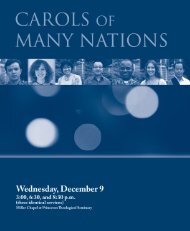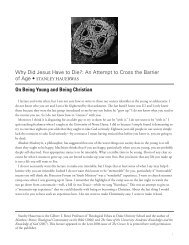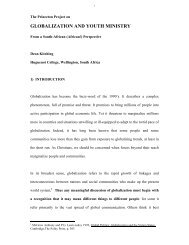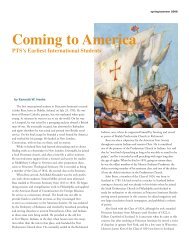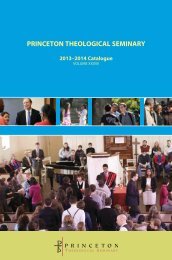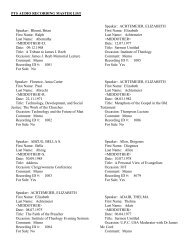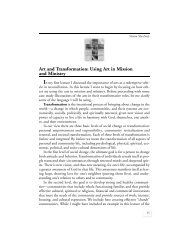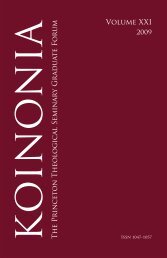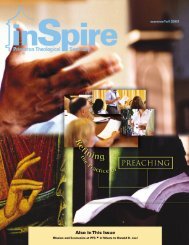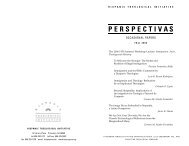PTS Catalogue - Princeton Theological Seminary
PTS Catalogue - Princeton Theological Seminary
PTS Catalogue - Princeton Theological Seminary
You also want an ePaper? Increase the reach of your titles
YUMPU automatically turns print PDFs into web optimized ePapers that Google loves.
except in the literal sense. They were prophetic enough, however, and among other<br />
things the “Design” noted that the purpose of the <strong>Seminary</strong> was<br />
to unite in those who shall sustain the ministerial office,<br />
religion and literature; that piety of the heart, which is the<br />
fruit only of the renewing and sanctifying grace of God, with<br />
solid learning; believing that religion without learning, or<br />
learning without religion, in the ministers of the gospel, must<br />
ultimately prove injurious to the church.<br />
The dialectic suggested in the juxtaposition of piety and learning deserves some<br />
comment. It is an apt text for expounding the peculiar genius of <strong>Princeton</strong> <strong>Seminary</strong><br />
and its view of theological education. The piety side of the formula stems from the<br />
accent on personal salvation, the experience of repentance and forgiveness, the<br />
Christian life of faith, justification, and sanctification, the reality of new selfhood in<br />
Jesus Christ, all of which can be traced to the roots of American religion, whether of<br />
the Puritan, Calvinist, Lutheran, Quaker, Wesleyan, or “left-wing” Reformation traditions.<br />
So it was that <strong>Princeton</strong> <strong>Seminary</strong>, as was true of most other divinity schools,<br />
deliberately defined itself as a school of “that piety of the heart,” a training center<br />
for church leaders of all sorts, which specialized in preaching, the cure of souls,<br />
evangelism, and missions. To be sure, there were many at <strong>Princeton</strong> unsympathetic<br />
with much of the methodology of the new pietism and revivalism; but regarding the<br />
religious goals interpreted as personal salvation, “the fruit only of the renewing and<br />
sanctifying grace of God,” there was unanimity between thumping revivalists and<br />
proper <strong>Princeton</strong>ians.<br />
The other side of the piety-learning formula was equally important for the founders<br />
of the <strong>Seminary</strong>. The new institution was never described as a Protestant monastery<br />
or retreat, a place distinguished mainly for prayer and meditation. It was to be a<br />
school with teachers and students, library and books, ideas of the mind as well<br />
as convictions of the heart, all in the service of “solid learning.” The Reformed<br />
tradition, to which <strong>Princeton</strong> <strong>Seminary</strong> was and is committed, has always magnified<br />
intellectual integrity of the faith. Theology has been a highly respected word on<br />
the campus. Systems and structures of thought, reflection on the meaning and<br />
application of the faith, clarity of expression, and precision of definition—these are<br />
recognized norms for theological thinking.<br />
The <strong>Seminary</strong> has been served by a remarkable succession of eminent presidents.<br />
Francis Landey Patton (1902–1913) came to the <strong>Seminary</strong> after serving as president<br />
of <strong>Princeton</strong> University. J. Ross Stevenson (1914–1936) guided the <strong>Seminary</strong> through<br />
some turbulent years and expanded the institution’s vision and program. John A.<br />
Mackay (1936–1950) strengthened the faculty, enlarged the campus, and created a<br />
new ecumenical era for theological education. James I. McCord (1959–1983), whose<br />
presidency saw the institution of the first center of continuing education at a theological<br />
seminary, the establishment of full endowment for twenty-six faculty chairs,<br />
and the construction or renovation of major campus residences and academic facilities,<br />
gave leadership to both the national and world church through denominational<br />
and ecumenical councils.<br />
!# 27#"<br />
cat1213


